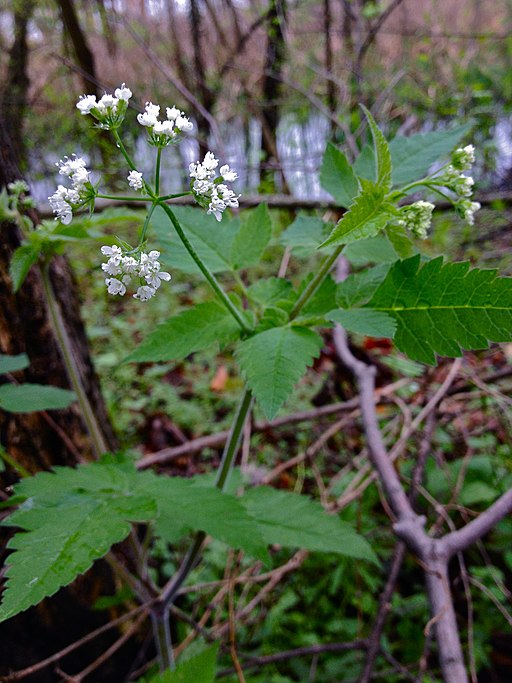Classification System: APG IV
Superregnum: Eukaryota
Regnum: Plantae
Cladus: Angiosperms
Cladus: Eudicots
Cladus: Core eudicots
Cladus: Asterids
Cladus: Campanulids
Ordo: Apiales
Familia: Apiaceae
Subfamilia: Apioideae
Tribus: Scandiceae
Subtribus: Scandicinae
Genus: Osmorhiza
Species: Osmorhiza longistylis
Name
Osmorhiza longistylis (Torr.) DC., 1830
Synonyms
Osmorhiza aristata var. longistylis (Torr.) B.Boivin
Osmorhiza cordata Raf.
Osmorhiza longistylis var. brachycoma S.F.Blake
Osmorhiza longistylis var. imbarbata Salamun
Osmorhiza longistylis var. villicaulis Fernald
Osmorhiza villicaulis (Fern.) Rydb.
Osmorhiza villosa Raf.
Washingtonia longistylis (Torr.) Britt.
Distribution
Native distribution areas:
Continental: Northern America
USA (Alabama, Arkansas, Colorado, Connecticut, District of Columbia, Delaware, Georgia, Iowa, Illinois, Indiana, Kansas, Kentucky, Massachusetts, Maryland, Maine, Michigan, Minnesota, Missouri, Mississippi, Montana, North Carolina, North Dakota, Nebraska, New Hampshire, New Jersey, New Mexico, New York, Ohio, Oklahoma, Pennsylvania, Rhode Island, South Carolina, South Dakota, Tennessee, Texas, Virginia, Vermont, Wisconsin, West Virginia, Wyoming), Canada (Alberta, Manitoba, New Brunswick, Nova Scotia, Ontario, Prince Edward Isl., Quebec, Saskatchewan)
References: Brummitt, R.K. 2001. TDWG – World Geographical Scheme for Recording Plant Distributions, 2nd Edition
References
De Candolle, A.P., Prodr. 4: 232 (1830)
Links
Hassler, M. 2018. Osmorhiza longistylis. World Plants: Synonymic Checklists of the Vascular Plants of the World In: Roskovh, Y., Abucay, L., Orrell, T., Nicolson, D., Bailly, N., Kirk, P., Bourgoin, T., DeWalt, R.E., Decock, W., De Wever, A., Nieukerken, E. van, Zarucchi, J. & Penev, L., eds. 2018. Species 2000 & ITIS Catalogue of Life. Published on the internet. Accessed: 2018 Sep 01. Reference page.
International Plant Names Index. 2018. Osmorhiza longistylis. Published online. Accessed: Sep 01 2018.
The Plant List 2013. Osmorhiza longistylis in The Plant List Version 1.1. Published on the internet. Accessed: 2018 Sep 01.
Tropicos.org 2018. Osmorhiza longistylis. Missouri Botanical Garden. Published on the internet. Accessed: 2018 Sep 01.
USDA, ARS, Germplasm Resources Information Network. Osmorhiza longistylis in the Germplasm Resources Information Network (GRIN), U.S. Department of Agriculture Agricultural Research Service. Accessed: 07-Oct-06.
Vernacular names
English: Longstyle sweetroot
Osmorhiza longistylis, commonly called long-styled sweet-cicely[1] or longstyle sweetroot,[2] is an herbaceous plant in the family Apiaceae. It is native to North America, where it is found from the Rocky Mountains east to the Atlantic Coast, in Canada and the United States.[3] Its natural habitat is in forests with fertile soil, often in areas of loam and dappled sunlight.[4][5] It can be found in areas of high or average quality natural communities,[5] and does not tolerate intense disturbance.
It is an herbaceous perennial that grows to two and a half feet tall. It produces umbels of small white flowers in late spring and early summer. The crushed plant has a distinct scent of anise.[5]
Uses
The roots have occasionally been used as a culinary substitute for anise.[6] This species was also used historically by Native Americans as a medicinal herb.[7]
References
Osmorhiza longistylis New England Wildflower Society
"Osmorhiza longistylis". Natural Resources Conservation Service PLANTS Database. USDA. Retrieved 14 August 2018.
"Osmorhiza longistylis". County-level distribution map from the North American Plant Atlas (NAPA). Biota of North America Program (BONAP). 2014. Retrieved 14 August 2018.
Alan Weakley (2015). "Flora of the Southern and Mid-Atlantic States".
Aniseroot Osmorhiza longistylis IllinoisWildflowers
Yatskievych, George (2006). Flora of Missouri, Volume 2. Missouri Botanical Garden Press. p. 94.
University of Michigan - Dearborn (OSLO): Native American Ethnobotany — Osmorhiza longistylis
Retrieved from "http://en.wikipedia.org/"
All text is available under the terms of the GNU Free Documentation License


